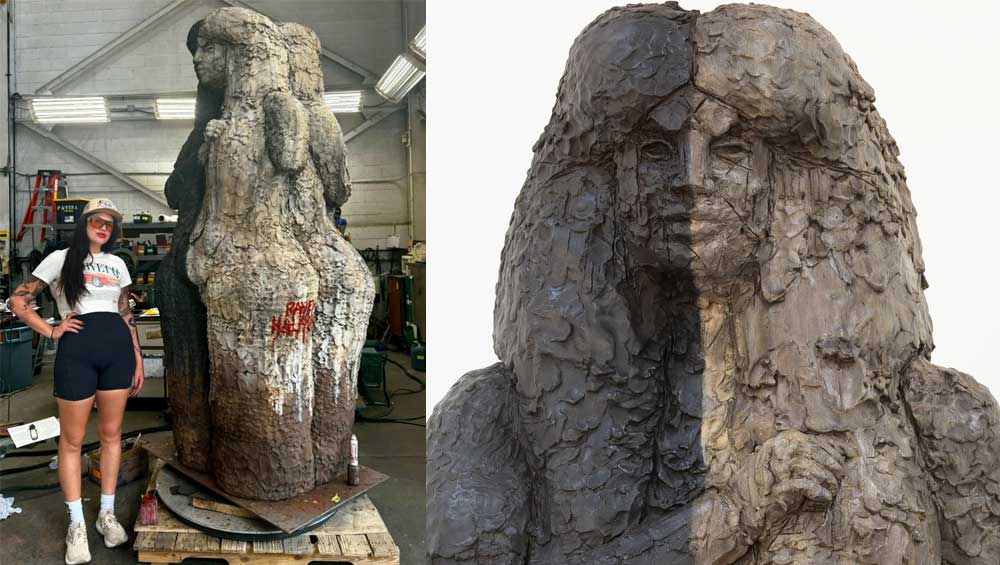
Raven Halfmoon with The Guardians. Images courtesy of the artist and Salon 94. © Raven Halfmoon.
by CHRISTIANA SPENS
This September, sculptor Raven Halfmoon (b1991) of the Caddo Nation, from Norman, Oklahoma, is exhibiting Neesh & Soku (Moon & Sun) at Salon 94, bringing monumental sculptures made of travertine and bronze, as well as her signature clays. At the centre of the exhibition is the artist’s formidable 2.75-metre-high (9ft) bronze sculpture, which she produced during a residency at Urban Art Projects in Rock Tavern, New York, and which is inspired in part by the giant carved moai figures on Rapa Nui (Easter Island).
Neesh & Soku also includes further works in bronze, stone and clay, which explore the binaries of womanhood, in striking, sensual figures wearing dush-tohs, traditional Caddo hairpieces worn by girls and women during ceremonial dances. Halfmoon also plays with contemporary motifs and props – from men smoking cigarettes to tattoos and tags – marrying the ancient wisdom passed down to her from her ancestors with familiar and personal pop cultural details. The artist’s stoneware, glazed mostly in deep reds, earthy creams, brown and black, aligns contemporary methods with her reinterpretations of her tribe’s ancestral narratives, identity and feminist lineages.
She spoke to Studio International on Zoom about her upcoming show.
Christiana Spens: Your new works, made of travertine and bronze, are so impressive. Can you tell me a little more about the inspiration behind them, and the process of making them? They seem so tactile.
Raven Halfmoon: I’m a very tactile person. I think that’s why I work with clay. You will be able to touch them, but I also laid my fingerprints in everything, so that makes you want to touch them, I think.
CS: That’s so interesting, that seeing someone else’s mark makes you want to touch them.
RH: Yeah, I say this a lot too, but one of the first painters I really loved was Vincent van Gogh, when I studied him at school, and then I went and saw his work and you can really see all the brushstrokes in his painting, and that made me gravitate towards him even more. It was if I was in that space with him, when he was creating it, and it created a sense of intimacy, like I knew him. Ever since I saw those paintings when I was little, I wanted to have that same moment, and so I began leaving those prints in my own work.
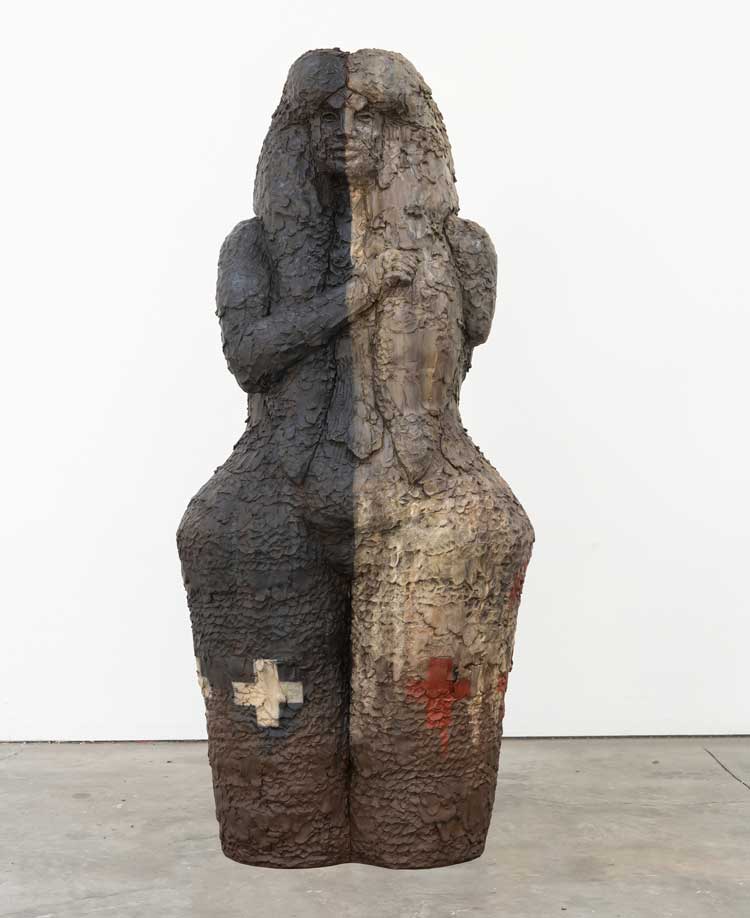
Raven Halfmoon. The Guardians, 2024. Bronze, 274.3 x 120.3 x 111.2 cm (108 x 47.38 x 43.79 in). Image courtesy of the artist and Salon 94. © Raven Halfmoon.
CS: Your momentous new sculpture, The Guardians, which is 9ft tall and cast in bronze, is central to the show at Salon 94. Can you tell us about how you conceived of this project, and the process by which you created it? What were your influences? How intentional or planned are these marks, and how much do you decide in the moment?
RH: With building those pieces, I work in my sketchbook a lot. I draw, I sketch everything out, and that’s where I come up with proportions, colours – I use coloured pencils, and markers and Sharpies. Sometimes, I’ll sketch them really big too. With that bronze piece, I needed to sketch that at 9ft tall. I had to see it proportionately, where everything was going to line up. However, a lot of decisions are made in the moment. I think something’s going to look good in the sketchbook and then, once I build it, I change my mind. So, a lot of those fingerprints, that’s all in the moment; but for example, the bronze piece, I had a plan when I went to build her. I had three weeks to build, and to make that out of clay first, that was 9ft. I really had to have a pretty strategic plan to go in there and make it.
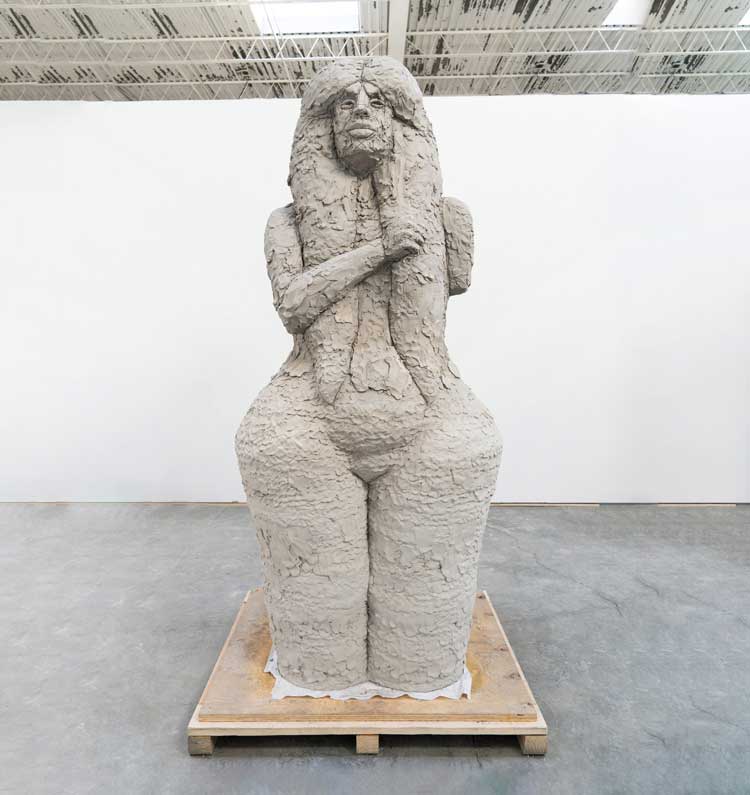
Raven Halfmoon. The Guardians, 2024. Clay, in process. Image courtesy of the artist and Salon 94. © Raven Halfmoon.
CS: In this latest show, you have taken your own name as a departure point, so as to explore binaries – lightness and darkness, male and female, traditional and contemporary, and so on. Can you tell me more about your interrogation of these ideas?
RH: The bronze piece as well as the stone pieces are influenced by a lot of different things: Soku and Neesh, which means “sun and moon” in Caddo, for the title of the show; the light and dark, which is in our origin story, where the Caddo came out of the darkness in the ground and were led by a man named Tasha (which means wolf) into the place of light. I grew up learning that story as a kid – that we come from under the earth and then, when we die, we go back into the earth. I wanted to name the show to pay homage to these stories, to these ideas of light and dark.
These are also themes that I have recently experienced in my life. I think we all carry a balance of lightness and shadow, or darkness, always carrying both within us. I really wanted to show the ideas of black and white, light and dark, sun and moon, throughout the work. You can also see it in the stone; the bottom of the stone is going to be dark, and the top is going to be white; again, to balance these things that we have within us. It’s the sun and the moon, and good and bad, and I explore these binaries and how they exist in ancient knowledge and then contemporary knowledge, having all these lessons and stories that my family have passed down to me and then carrying that through in my work today. It’s this idea of past, present and future being connected in this way. All these things that I’ve experienced and continue to experience today are my reflection of that. So, I use a lot of black and white in my glazing to carry those ideas forward; there’s a lot of that palette in this show.
I had a mental low moment not too long ago, so I think this show, too, is about carrying both those things with us as we live life. We have ups and downs, go through good things and bad things, and a lot of that light and dark is about having to learn to balance both of those. You’ll see a lot of that in the work.
CS: These works also feel very grounded, and I find it interesting that you have the stone and the clay and then you have this reflective material, the bronze, so you are always balancing a sense of real weight and groundedness with material that is reflecting and absorbing light. And then with the bronze, again, I know it reflects light, but for me, compared with other metals, it feels very earthy and dirty. You have light and dark, but then you have gravity and earth versus the sky and light, and in this one material you have all of that happening at once.
RH: Yes. And a lot of the big inspirations for me come from when I was in school, not only studying art, but also anthropology, so I studied these large-scale earth works, these large mounds in America, in Tennessee and Ohio, which were created by our ancestors. You can go to Oklahoma, Arkansas, Alabama, and see some of these really large pieces that are thousands of years old. They’re large-scale earth works, where people moved the earth around and made these beautiful patterns that you wouldn’t even be able to see unless you were high in the sky. And these were a big influence on me and especially this idea that not just one person, but a committee made them; it takes more than one individual to make something. When I was in school, studying anthropology, the moai figures on Rapa Nui really blew me away, and also Stonehenge – and this idea of moving these large-scale pieces that are in the earth. How many people did it take to move those pieces and what was the technical aspect? This all fascinated me.
Caddos traditionally made pottery with clay from the earth, as well – usually a dark chocolate-brown clay or a black clay body – so I have a lot of that in my own work. Our clay is very gritty; it’s strong, it’s earthy, so these are the same things I want to show in bronze and stone. That was very important to me. Even in the stone, you’ll see that it’s not perfect, there are stripes in it, variations of colour, holes in the travertine. I didn’t want to use marble, I wanted to use travertine, which is a stone you can find here in America, so that was important.
I wanted to reflect all this in these materials. What you’re saying, too, with the bronze, there’s a weight to it, it’s also that same colour; these are all materials that are strong and thick and stand the test of time. They’re how I build and think about my work, so it was a natural progression to move into these other materials. I’m also kind of limited because clay can only build so big, and one of the pieces that you’ll see here is going to be 8ft, and it’s out of clay; however, I think the biggest kiln in America is about that size. I’m able to travel sometimes to residencies that have bigger kilns to use, but about 8ft or 9ft is the biggest kiln I’ve ever worked with.
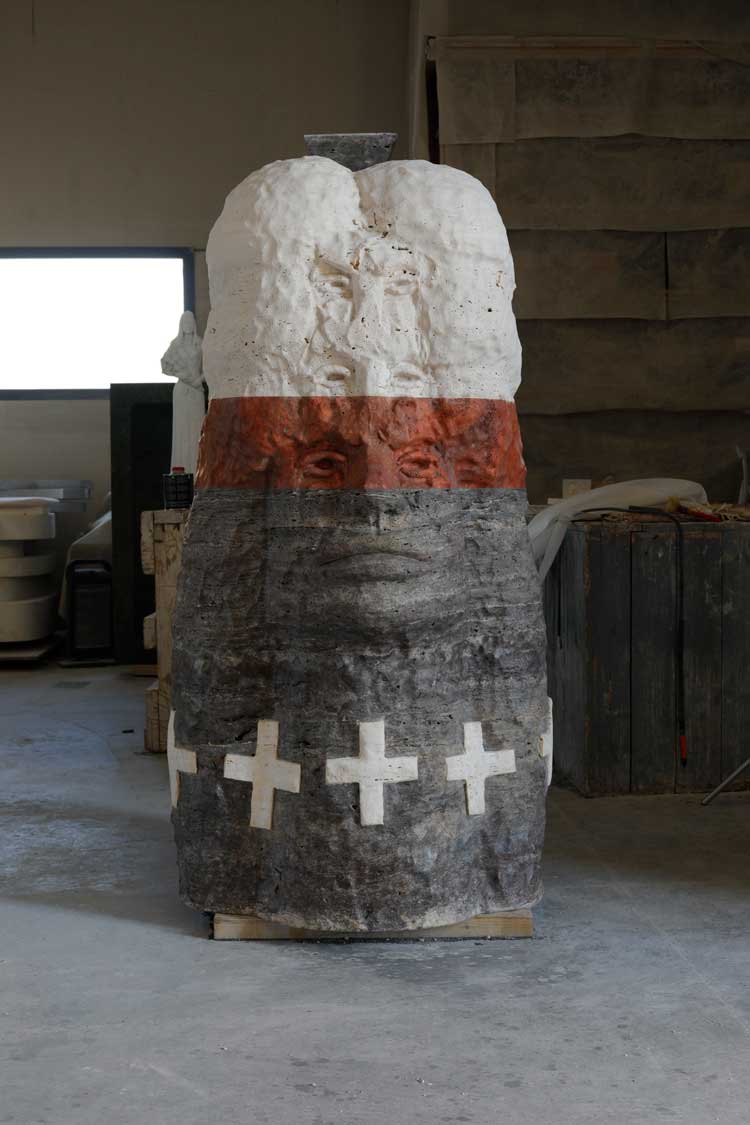
Raven Halfmoon. Dancing at Dusk, 2024. Travertine, 182.9 x 91.4 x 91.4 cm (72 x 36 x 36 in). Image courtesy of the artist and Salon 94. © Raven Halfmoon. Photo: Paola Tazzini Cha.
CS: It must be a massive endeavour to make these pieces. And to transport them as well.
RH: It was. It took everything in me to make these, especially the bronze piece, because I made it physically; that just about killed me. Literal blood, sweat and tears went into these pieces.
CS: You reference Caddo tattooing and popular culture in your work, as well as ancestral narratives, identity and heritage. Can you tell me about the ways in which these influences emerge in your practice?
RH: I always think of it as two worlds; two worlds of living – having all this knowledge that my ancestors and my family gave me and taking them forward for the next generation; it’s also about sharing my history. I feel like a lot of people don’t know about Caddos or Native history, so it’s balancing these two worlds.
I also just really like the colour red; the red symbolises a lot of different things for me – makeup, tattooing, as you mentioned, and it can represent blood. For this show in particular, there is a lot of black, white and red; there are some other colours, too, like yellow and blues, but it’s a lot of cream, dark chocolate brown and reds because those colours are important to me in the ways I just mentioned, but also aesthetically. I like things that have high contrast, that are really graphic; I like how they make my work look. Because I glaze in those colours a lot, they feel powerful.
CS: They are kind of calming, for me. Maybe people have different reactions, but I get a grounded feeling when I see them together. I just realised as well that you are wearing black, white and red.
RH: Yes, they’re my favourite colours to wear as well.
CS: Do you find when you use certain colours in your practice that it extends everywhere else in your life?
RH: It does, yes. In some new work, I’m using some blues and pinks and introducing new colours to that black-and-white palette, and I am finding them coming into my clothes and my nails.
CS: Do you feel as if you live those colours when you are working on a project, as if you are that involved with the aesthetic of it?
RH: Yes, I do, because that work, it takes a lot of my essence, mentally, conceptually, physically – all the time, the blood, sweat, and tears. That piece is me; it has my essence in it. Especially that bronze piece, I would talk to her, pray to her. They’re powerful. I’m excited to go to see her in about two weeks. I left her in clay and now she’s born of bronze, so I’m pretty excited about it.
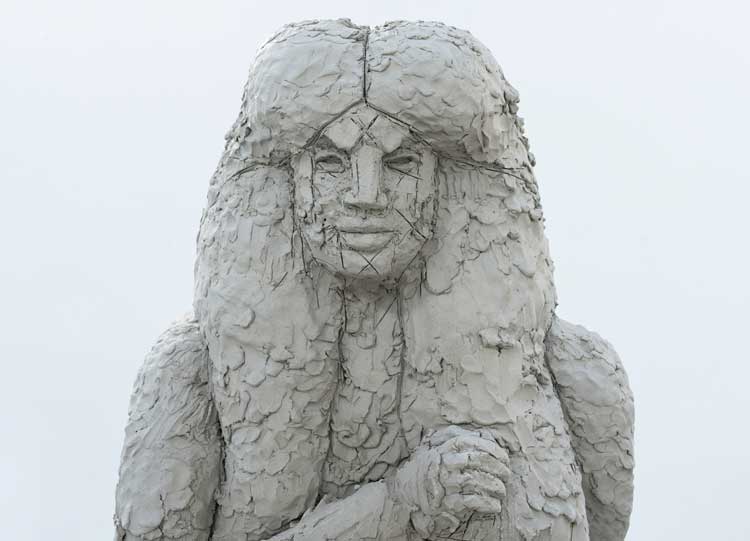
Raven Halfmoon. The Guardians, 2024. Clay, in process. Image courtesy of the artist and Salon 94. © Raven Halfmoon.
CS: The bronze must absorb heat as well; do you ever feel the warmth off it?
RH: Yes, you can; she will be outside. She’ll absorb the sun, the moon. Every time there’s a full moon, I’ll go and do a little blessing, so she’ll receive all that. I’m excited about that.
CS: That’s very cool. So, by the time she gets to the exhibition, she will have already gone through these months and these moons, and the sculpture will have this history to it already.
RH: Exactly.
CS: Can you tell me a little more about the other female figures in the show?
RH: The stone sculpture has a head piece called a dush-toh, which is what women wear, and we’re one of only two tribes where women wear the dush-toh when we dance. It’s part of our regalia, and so she’s wearing it, and she has fully long hair, and then it’s the same with the bronze piece. I was going to have her arms go down the side, but instead I did one of them going over her heart, so there are two women back-to-back and their hands over their hearts, so that when you walk around them it makes an infinity symbol. It feels powerful and sacred, and it’s also a way to tell someone, like, I love you, or it’s also a power stance.
CS: What about the smaller works you are working on now? Presumably, you don’t have to plan them out in quite the same way?
RH: With those, I will decide I want to make a bust, or I want to make a figure, or I want to make a horse. For those, my plan is a little bit looser. With these smaller ones, I’m making in the studio now, I wanted them to feel even more personal and contemporary, connected to some things that I’m experiencing, and so a couple of them are holding a cigarette, and a couple of them have a cowboy hat, and that was all in the moment. I knew I wanted their hair down and then I decided, you know what, I’m going to have their hands do a little something different. And I recently bought a horse and so these are things that I’m doing now.
CS: I guess that is an interesting subversion as well as the whole cowboys thing presumably; I mean that is quite interesting.
RH: Yeah, being from here in Oklahoma, there’s all this cowboys and Indians stuff, so it brings all that history, and it plays with that, and then the modern man as well, with the cigarette.
CS: Like the Marlboro Man … that’s really interesting.
RH: Yeah, in the show there will be some smaller pieces that will be more modern, with the smoking and the hats and maybe how their hair is styled. But I wanted to feel that they still have my touch to them, so they’re kind of ancient in a way, too. It is kind of weird to say that they’re both, but they do they feel as if they could have been made thousands of years ago, and also today.
CS: And in a way they are.
• Raven Halfmoon: Neesh & Soku (Moon & Sun) is at Salon 94, New York City, from 18 September – 2 November 2024.